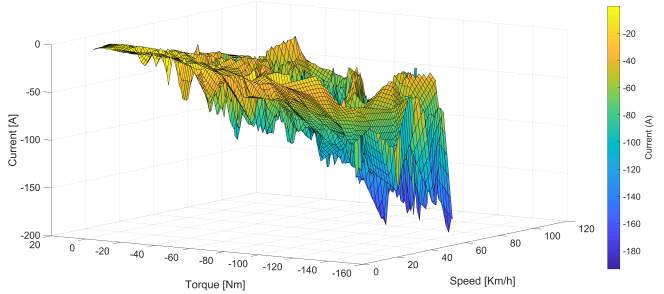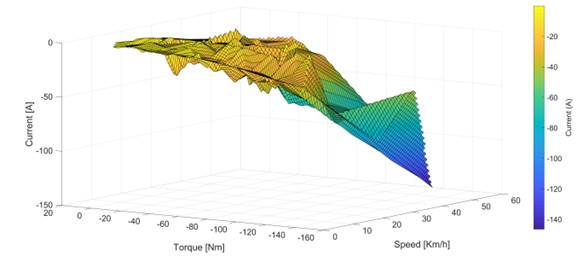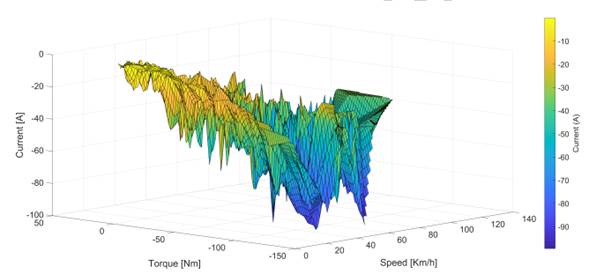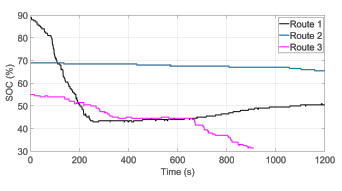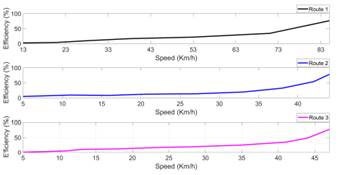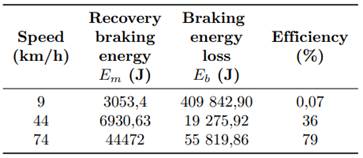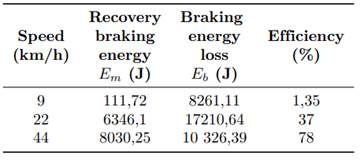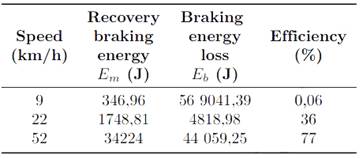|
Scientific Paper / Artículo Científico |
|
|
|
|
https://doi.org/10.17163/ings.n29.2023.02 |
|
|
|
pISSN: 1390-650X / eISSN: 1390-860X |
|
|
ANALYSIS OF REGENERATIVE BRAKING EFFICIENCY IN AN
ELECTRIC VEHICLE THROUGH EXPERIMENTAL TESTS |
||
|
ANÁLISIS DE LA EFICIENCIA DEL FRENO REGENERATIVO EN UN VEHÍCULO ELÉCTRICO MEDIANTE PRUEBAS EXPERIMENTALES |
||
|
Received: 14-04-2021,
Received after review: 13-12-2021, Accepted: 24-01-2022, Published:
01-01-2023 |
|
Abstract |
Resumen |
|
This paper presents a regenerative braking
analysis of efficiency in real driving conditions and different road
geographies. Factors affecting or benefiting energy recovery were identified, these are: the weight of the vehicle,
torque, speed, inclination of road, and braking time; however, the sport and
Eco driving modes were not considered because the same driving pace was
chosen for the different routes. These results are intended
to collaborate with real energy regeneration data and help investigators,
academics, and automotive engineering, improving this system’s efficiency. In
the driving process, the state of charge (SOC), speed, torques, and road
geography effect the efficiency of regenerative braking, as driving a vehicle on a road with irregular geography exposes
it to aggressive physical factors, which considerably reduces its energy
autonomy. The main aspects of recovery and regenerative braking efficiency
were determined through quantitative data analysis, resulting in experimental
surfaces and curves, which present the performance of current and
deceleration during vehicle braking. Thus, it is shown
that the energy recovery during braking is 78% considering the low autonomy
of the electric vehicle. |
Este artículo presenta un análisis de la eficiencia del frenado regenerativo en condiciones reales de conducción y en diferentes geografías de carretera. Se identificaron los factores que afectan o benefician a la recuperación de energía, estos son: el peso del vehículo, el par, la velocidad, la inclinación de la calzada y el tiempo de frenado; no obstante, no se consideraron los modos de conducción deportivo y Eco debido a que se optó por un mismo ritmo de conducción en las diferentes rutas. Estos resultados pretenden colaborar con datos reales de regeneración de energía y ayudar a los investigadores, académicos e ingenieros de automoción, a mejorar la eficiencia de este sistema. En el proceso de conducción, el estado de carga (SOC), la velocidad, torques y la geografía de la carretera afectan a la eficiencia del frenado regenerativo, ya que conducir un vehículo por una carretera con una geografía irregular lo expone a factores físicos agresivos, lo que reduce considerablementesu autonomía energética. Se determinaron los principales aspectos de la recuperación y la eficiencia del frenado regenerativo mediante análisis de datos cuantitativos, dando como resultado superficies y curvas experimentales, que presentan el rendimiento de la corriente y la desaceleración durante el frenado del vehículo. Así, se demuestra que la eficiencia de recuperación de energía durante el frenado es de un 78% considerando la baja autonomía del vehículo eléctrico. |
|
Keywords: Brake pedal, electric vehicle, energy
recovery, regenerative braking |
Palabras clave: Pedal de freno, vehículo eléctrico, recuperación de energía, freno regenerativo |
|
1,* Grupo de Investigación de Ingeniería del Transporte (GIIT),
Carrera de Ingeniería Mecánica Automotriz, Universidad Polítecnica
Salesiana, Cuenca, Ecuador. 2 Grupo de Investigación En Control,
Electrónica De Potencia y Gestión De La Innovación Tecnológica (CEPIT)
Departamento de Ingeniería Electrónica, Pontificia Universidad Javeriana,
Bogotá, Colombia. Corresponding author ✉: aguiracochac@est.ups.edu.ec Suggested
citation: Valladolid, J.; Calle, M. and Guiracocha, A. “Analysis of regenerative braking
efficiency in an electric vehicle through experimental tests,” Ingenius, Revista de Ciencia y Tecnología, N.◦
29, pp. 24-31, 2023, doi: https://doi.org/10.17163/ings.n29.2023.02. |
|
1. Introduction Electric vehicles (EV) are very attractive and have generated interest
in science, academia, and public and private transportation systems at a
global scale [1–3]. In this type of vehicle, the search to improve the system efficiency
is essential; since it presents an important alternative of transport
compared to conventional vehicles with internal combustion engines.
Nevertheless, these vehicles have a limited driving autonomy, and this factor
continues to be the main obstacle for the mass acceptance and use of EVs [1],
[2], [4], [5]. As opposed to conventional vehicles and in
addition to reducing air contamination, EVs can recover part of the energy
lost in the braking process thanks to the regenerative braking system, thus
improving the driving autonomy of electric vehicles [6]. Irregular road geography exposes vehicles to factors
at an altitude on the mountain road. In relation to energy consumption, these
factors require more performance of batteries in electric vehicles,
especially on mountain routes. In this sense, the slope of the road is a
factor that cannot be neglected in the design of
strategies for optimizing regenerative braking [7, 8]. In a regenerative braking system, energy is transferred to generators under a strategy of
integrated control, which consists of generating an estimate for the
deceleration by the driver and distributing the needed braking force between
the regenerative system and mechanical braking [9]. In literature, the authors
consider that the deceleration rate and the mass of the vehicle have
significant effects in the regenerative braking threshold at low speeds, as
it is considered that a regenerative brake at low speed is effective in the
city, because more action is needed in the braking system for the heavy
traffic, thus increasing the power and autonomy of the vehicle [4], [10]. Strategies of regenerative
braking that take into account the slope of the road, are
considered by other authors to be more efficient. A noticeable
improvement can be seen in the recovery of energy
[8]. In other literature
they show through simulations that the lowest energy consumption happens with
a complete braking system in series, due to better use of the braking torque
and therefore less energy is consumed [11]. The potential energy consumption
is lower in road travel than in a driving in the urban area, where there is
little brake actuation affecting the energy recovery in the EV vehicle [12]. In the present work, experiments are carried out on the EV on established routes to
determine the efficiency of the regenerative brake, its performance and its
influence on the autonomy of the EV. Behavior maps were
used to analyze the influence of factors such as braking time, initial
braking speed, and road grade on energy recovery. The maximum and minimum
recovery energy percent per range will be estimated
numerically. |
The paper is organized as follows: In Section 2, the mathematic
support of regenerative braking is presented, describing with detail
subsystems such as the dynamical model; in Section 3, the energy efficiency
and performance on regenerative braking are presented. Finally, the
conclusions of this study are presented in Section
4. 2.
Materials and methods 2.1.Traditional SOC estimation This method mainly uses the battery discharge
current as input and integrates the current discharge over a period to calculate
the SOC state [13], the equation (1) is as follows.
Where Cn
corresponds to the nominal capacity of the battery, i(t) corresponds to the
current flowing in and out the battery and t is the time. On the other hand, this
other calculation method requires a variation to Equation (11), multiplying a
coulombic efficiency factor (µi) to the integral, which is represented between the
discharge capacity and load capacity, represented in the equation (2).
2.2. SOC status The charge is
expressed in the equation (3).
The SOC is the
charge level of a battery expressed as a percentage, the equation (4) is.
2.3. Evaluation of the recovery of the energy Evaluating energy recovery in regenerative braking mainly includes the energy recovery capacity during braking and the energy recovery rate during braking [14]. Where, Em is the energy recovery presented in Equation (5).
Where, Ub(t) is the voltage at the motor controller while
recovering braking energy, ib(t)
is the motor controller current present in the braking action, and t
time of braking of the motor. |
|
2.4. Measure of energy recuperation of
braking Braking energy recovery
measurement, nb is the relation
between energy Em and the total
consumed energy. Eb is the energy
lost calculated as a function of the velocity of the start and end of
braking, as shown in the equation (6).
Where, m is
the mass of the vehicle, V0 is the initial velocity of
braking, Vf is the final velocity of braking, and nb is the efficiency shown in the
equation (7)
Equation (7) allows to determine efficiency values of regenerative braking
mainly using the initial velocity used by the vehicle to start the braking
process. 3.
Results and discussion The results in real driving
experimental tests are represented in this section
with the use of Matlab and Electric Mobility
Laboratory (Emolab) software to determine the
parameters that affect the efficiency of regenerative braking [15]. 3.1. Variables involved in energy recovery
process Emolab was used
in order to obtain the variables of the vehicle. Emolab
registers in real time are: the battery |
Current, the vehicle
speed, the motor torque, and the SOC [14]. Matlab was used to model this data in the braking process in real
driving. Performance surfaces were generated, where
the relationship between torque and speed is observed. In this manner, when
values for torque and speed are changed, the system outputs a new value of
energy recuperation charge, which influences the autonomy of the vehicle. The geography of
route one presents a higher slope which translates into a
higher power demand of the vehicle in order to overcome pronounced
inclinations. The principal variable of route two was a high degree of traffic which caused braking more often. Meanwhile, route
three presented a combination of these two factors, considerable slopes and
traffic of the routes one and two. Figures 1, 2 and 3
show that variables such as velocity and motor torque play key roles in
energy recovery during the braking process; since during the braking action
the system generates current by means of an AC motor, which is represented
with negative values. In this case, energy regeneration in the vehicle is affected by the speed, and therefore the braking torque
applied to the vehicle. Figure 1 indicates a
greater recovery of energy, because the geography of route one has different
types of roads and inclinations. These characteristics also allow higher
vehicle speeds, and consequently, longer times of brake application,
resulting in greater motor torques and greater currents. |
|
Figure 1.
Variables affecting energy recovery in route 1 |
|
|
Figure 2. Variables affecting energy recovery in route 2
Figure 3. Variables affecting energy recovery in route 3 |
|
|
3.2.
SOC behavior This section
presents the SOC performance of the three types of routes, taking into
account the type of road and the elapsed driving time during each route. In
Figure 4, the different SOC performances can be seen
for each route and different length. Route one has a greater inclination
across all its trajectory, and it tends to discharge
at a rate of 47%. The battery of the vehicle was discharged
aggressively because of the high-power demand it endures in overcoming the
considerable route geography. After a certain point, the geography of this
route changes to an only downward slope. While descending, the vehicle
recovers 9% of its charge because of the longer brake times and high speeds
up to 70km/h, as can be seen in Figure 1 |
and the resulting elevated motor
torques. Route two only has a discharge process. Figure 2 shows low
velocities in the range of 30 - 60 km/h. The added amount of traffic results
in a more extended brake usage. The battery discharge tendency is almost
lineal during its entire trajectory since there is a variation of 5% of the
charge from its initial value. Route three presents a more abrupt discharge
process compared to route two. The road type is rural; it has more pronounced
slopes, a moderate power demand on the vehicle, less traffic and speeds in
the range of 50 - 100 km/h as shown in Figure 3. In this route, there is low
brake usage. Figure 4 shows certain points along this route where the
discharge is significant, reaching a 32% level until its end point. |
|
Figure 4. Behavior of SOC with respect to recovered energy 3.3. Deceleration Performance In this section, the
deceleration comportment during braking is explained.
Figure 5 presents a 1600 seconds sample of deceleration values during the
regenerative braking process, rendered with MATLAB. Results tend to vary with
factors such as inclination, driving style, and the road geography, provoking
a heterogeneous deceleration. The deceleration values observed favor energy
recuperation, because the state of the charge increases when the brake is
used, thus the vehicle recovers energy to continue moving forward.
Figure 5. Deceleration
regarding regenerative system application 3.4.Efficiency of
regenerative braking The efficiency
of regenerative braking was calculated using Eq (7). The most significant values are the initial and
final braking velocities, the recovered charge, and the weight of the
vehicle. Figure
6 shows the relationship between the initial braking velocity and the
efficiency for each route. These values are sampled
at specific points to better observe the behavior of the efficiency. In
routes 1, 2 and 3 in the driving process the different types of road
geography, slopes, and initial braking speeds have an impact on the
variability of the |
obtained efficiencies as shown in Figure
6. In route 1, the result of the average efficiency in the
specific sample is 23%, and due to the type of geography of the road it is
necessary the use of more power by the vehicle, so the brake pedal is not
used with high frequency The brake efficiency at its peak reaches up to 76%,
this is due to a longer braking time and the final speed reached.
Figure 6.
Efficiency of regenerative braking at specific speeds According
to Figure 6, values vary in route 2 because it presented a high vehicular
flow, low driving speeds and high use of the brake pedal,
hence there is greater efficiency of the regenerative system. In turn, this
efficiency tends to stabilize, resulting in greater energy recovery, since it
has optimal load values reaching an average of 24% and its highest efficiency
reaching a value of 78%. The
efficiency of route three shows values that vary with the road geography,
average braking velocities, and the amount of traffic. The average efficiency
was of 22% with a max value of 77%. In routes 1 and 3, the efficiency
decreases significantly and does not stabilize, resulting in low values close
to zero The
regenerative braking efficiency of each route is shown
to be dependent on the loss and recovered energy of the vehicle. The road
geographies, the initial braking velocity, and the time of brake application,
summarized in Table 1, are the main variables that affect the values of loss
and recovered energy. The values presented in Table 2 are
greatly improved by the extended use of the brake pedal even though
its velocity values are lower due to high traffic. There is lower consumption
of energy because there is no need for a high-power demand. Energy recovery
and high efficiencies are favored by a lack of
aggressive changes in the route. Table 3 shows that the vehicle has high energy loss compared to Table 2, due to the geography
of the road, high power when overcoming slopes and moderate use of the brake
pedal, resulting in lower energy recovery compared to Table 2. |
|
Table 1. Minimum, average and maximum efficiency of
the regenerative braking system in route 1
Table 2. Minimum, average and
maximum efficiency of the regenerative braking system in route 2
Table 3. Minimum, average and
maximum efficiency of the regenerative braking system on route 2
4. Conclusions In this paper, an analysis of the
regenerative braking system was carried out through real driving experiments,
where variables such as: current, torque and speed influence with respect to
the vehicle’s energy recovery were considered in order to determine the
efficiency and performance of the regenerative braking system. The difference
between the routes is the type of road geography, the vehicle driving time
and brake pedal actuation, so in route 1 it was possible to observe a greater
energy recovery due to the factors mentioned. With respect to the
state of charge (SOC) of the vehicle, it was observed
that the different powers used for each route and the type of geography are
significant variables for a greater energy loss. The results obtained
indicate that the use of the vehicle in route 2 has a progressive energy
loss, which at a certain time tends to stabilize because
of the greater use of the brake due to the high vehicular flow; |
while in route 1 a small energy
recovery was achieved due to the use of the brake due to the descent of steep
slopes. In the efficiency of
the regenerative braking system, the results demonstrate that the type of
road geography, initial braking speeds, brake usage, and vehicle mass are
variables that greatly influence the efficiency of this system. Additionally,
driving in route 2 is more efficient than in routes 1 and 3, as it has lower
energy loss values and high energy recovery values. References [1] P. Spichartz and C. Sourkounis,
“Influence of the braking system and the type of regenerative braking request
on the energy consumption of electric vehicles,” in 2020 Fifteenth
International Conference on Ecological Vehicles and Renewable Energies (EVER),
2020, pp. 1–7. [Online]. Available: https:
//doi.org/10.1109/EVER48776.2020.9242939 [2] J.
D. Valladolid, D. Patino, G. Gruosso,
C. A. Correa-Flórez, J. Vuelvas,
and F. Espinoza, “A novel energy-efficiency optimization approach based on
driving patterns styles and experimental tests for electric vehicles,” Electronics,
vol. 10, no. 10, 2021. [Online]. Available: https://doi.org/10.3390/electronics10101199 [3]
T. A. Skouras, P. K. Gkonis, C. N. Ilias, P. T. Trakadas, E. G. Tsampasis, and T. V. Zahariadis,
“Electrical vehicles: Current state of the art, future challenges, and
perspectives,” Clean Technologies, vol. 2, no. 1, pp. 1–16, 2020.
[Online]. Available: https://doi.org/10.3390/cleantechnol2010001 [4]
S. Heydari, P. Fajri, N. Lotfi, and B. Falahati,
“Influencing factors in low speed regenerative braking performance of
electric vehicles,” in 2018 IEEE Transportation Electrification Conference
and Expo (ITEC), 2018, pp. 494–499. [Online]. Available: https://doi.org/10.1109/ITEC.2018.8450260 [5] V. Totev and V. Gueorgiev,
“Efficiency of regenerative braking in electric vehicles,” in 2020 21st
International Symposium on Electrical Apparatus & Technologies (SIELA),
2020, pp. 1–4. [Online]. Available: https: //doi.org/10.1109/SIELA49118.2020.9167153 [6] Y. Wang and Y. Su, “A research for brake strategy based on fuzzy control in pure electric vehicles,” in 2015 4th International Conference on Computer Science and Network Technology (ICCSNT), vol. 01, 2015, pp. 689–693. [Online]. Available: https://doi.org/10.1109/ICCSNT.2015.7490838 |
|
[7] M. Gupta,
“Evaluation of regenerative braking and its functionality in electric
vehicles,” in 2020 International Conference for Emerging Technology
(INCET), 2020, pp. 1–6. [Online]. Available: https:
//doi.org/10.1109/INCET49848.2020.9154047 [8] J. Bian and B. Qiu, “Effect of
road gradient on regenerative braking energy in a pure electric vehicle,” Proceedings
of the Institution of Mechanical Engineers, Part D: Journal of Automobile
Engineering, vol. 232, no. 13, pp. 1736–1746, 2018. [Online]. Available: https://doi.org/10.1177/0954407017735020 [9] J. Zhang, X. Lu,
J. Xue, and B. Li, “Regenerative braking system for
series hybrid electric city bus,” World Electric Vehicle Journal, vol.
2, no. 4, pp. 363–369, 2008. [Online]. Available: https://doi.org/10.3390/wevj2040363 [10] T. T. Duong, D.
V. Do, and T. T. Nguyen, “Research on braking force distribution in
regenerative braking system apply to conventional vehicle,” in 2018 4th
International Conference on Green Technology and Sustainable Development
(GTSD), 2018, pp. 48–52. [Online]. Available: https://doi.org/10.1109/GTSD.2018.8595456 [11] Y. Zhang, C.
Zhao, and Z. Li, “Electric vehicle regenerative braking system simulation
based on kalman filter,” in 2020 Chinese
Automation Congress (CAC), 2020, |
pp. 2936–2941. [Online].
Available: https: //doi.org/10.1109/CAC51589.2020.9327759 [12] P. Spichartz and C. Sourkounis,
“Influence of the braking system and the type of regenerative braking request
on the energy consumption of electric vehicles,” in 2020 Fifteenth
International Conference on Ecological Vehicles and Renewable Energies (EVER),
2020, pp. 1–7. [Online]. Available: https:
//doi.org/10.1109/EVER48776.2020.9242939 [13] N. Watrin, B. Blunier, and A. Miraoui, “Review of adaptive systems for lithium
batteries state-of-charge and state-of-health estimation,” in 2012 IEEE
Transportation Electrification Conference and Expo (ITEC), 2012, pp. 1–6.
[Online]. Available: https://doi.org/10.1109/ITEC.2012.6243437 [14] Y. Sun, Y. Wang, R. Zhu, R. Geng, J. Zhang, D. Fan, and H. Wang, “Study on the control strategy of regenerative braking for the hybrid electric vehicle under typical braking condition,” IOP Conference Series: Materials Science and Engineering, vol. 452, p. 032092, 2018. [Online]. Available: https: //doi.org/10.1088/1757-899x/452/3/032092
[15] EmoLab. (2022) Grupo de Investigación en Ingeniería de Transporte. Universidad Politécnica Salesiana. [Online]. Available: https://bit.ly/3Sju2g
|



